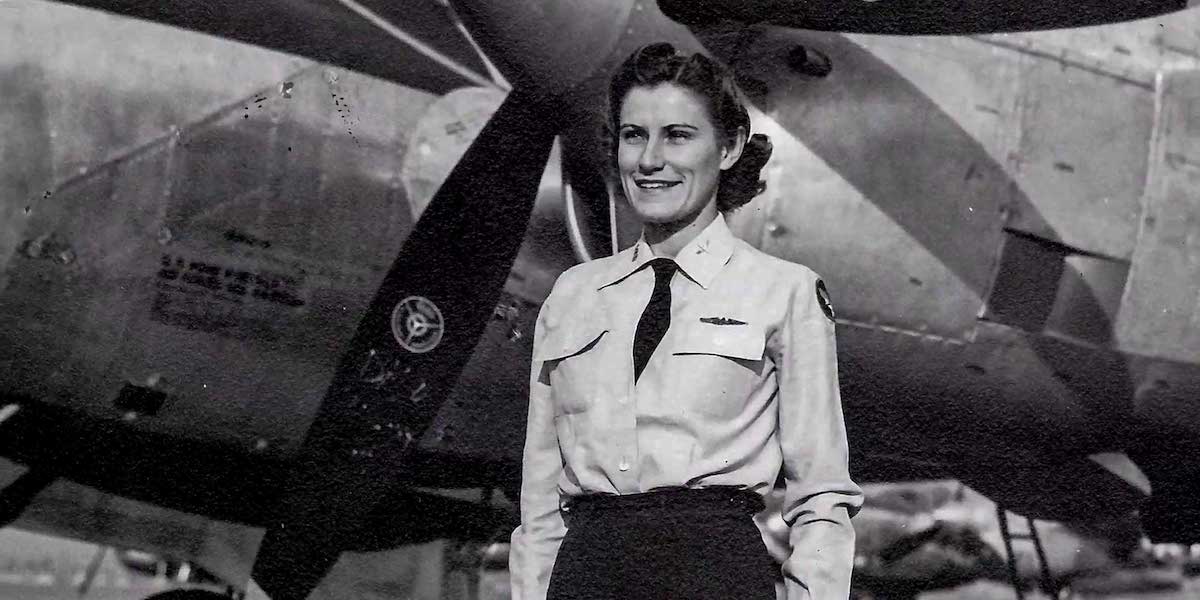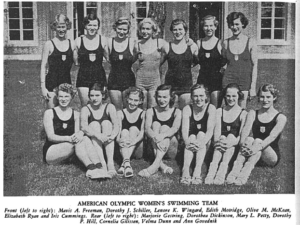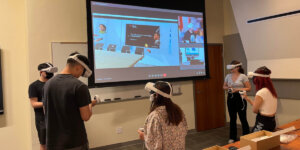
Iris Critchell, nee Cummings, earned her wings in 1939 at USC. In 1943 she was assigned to the 6th Ferrying Group at Long Beach, California. After WWII she spent more than 50 years teaching aeronautics classes and flight training. Critchell helped make aviation as safe as it is today.
The year was 1928 and the setting was sunny Los Angeles at one of the first ever National Air Shows.
Iris Critchell waited with her parents for The Three Musketeers to dazzle the 70,000 fans.
The only problem was that one of the Musketeers, their leader, was dead.
The Musketeers, the U.S. Army Air Corps’ stunt flying team, were known for their incredible aerial acrobatics and death defying formations. The previous day, however, one of the Musketeers — Lt. John Williams — had met with a fatal crash, casting a shadow over National Air Races.
The next day, September 11, 1928, the seven-year-old Critchell sat with her parents in the grandstands of Los Angeles’ Mines Field, now known as Los Angeles International Airport.
As the distant hum of biplanes heralded their arrival from the east, an announcer’s voice resonated through the crowd, announcing the arrival of the Three Flying Musketeers.
“The announcer in the stands said, ‘Ladies and gentlemen, we have the Three Flying Musketeers,’” Critchell said. “‘We lost the leader yesterday. Now, I want you to notice…Charles Lindbergh.’”
“I will always remember that moment.”
Critchell watched in awe as the Three Flying Musketeers performed breathtaking aerial stunts over the skies of Los Angeles, just a little over a year after Lindbergh completed the first transatlantic flight from New York to Paris.
Reportedly, The National Air Show sought to counter any negative publicity from the earlier mishap, instead wanting to showcase aviation safety. This experience sent the now 102-year-old Critchell on her life’s trajectory: to USC and a life in the clouds appreciating the privilege of flight.
From the Olympic Pool to the USC Engineering Program
Critchell’s upbringing was far from ordinary.
Her parents, a father who was both a doctor and an athlete and a mother who worked as a teacher, both served as civilians during World War I. They brought her up with the conviction that her potential knew no bounds. Her father, a medical practitioner and sports coach, instilled in her a love for sports, while her mother, a college-educated teacher, inspired Critchell with her academic pursuits – a rarity for women in her mother’s generation.
“I happened to have an unusual background and unusual education, both physical and academic, because my father brought me up in physical activity, moving in the ocean and doing swimming competitions and so forth,” Critchell said. “And then my mother was unusual because she was a college graduate and teacher, and women didn’t do that then.”
By the age of 15, Critchell had already become the American national 200-meter breaststroke champion, earning her a spot on the United States delegation for the 1936 Summer Olympics in Berlin. This was just the beginning of her remarkable journey. Following the Olympics, in 1937 she enrolled at the University of Southern California to pursue a degree in physical sciences and mathematics.
It was during her time at USC that she discovered her true calling: aviation.
“After my first two years at USC, I was old enough to consider my dream, which was to learn to fly,” said Critchell. “My parents would take me to a local airport and I started to learn to fly a little bit at a time.

The 1932 American Olympic Women’s Swim Team
In 1939, she learned about the Civilian Pilot Training Program initiated by the federal government’s Civil Aeronautics Authority (CAA) to train civilian pilots, with a focus on college students. USC was selected as one of the schools to participate in this program, and Critchell seized the opportunity, despite being the only woman among 50 students in the USC College of Aeronautics.
The Civilian Pilot Training Program taught at the nearby Gardena Valley Airport — now an abandoned airfield — was an innovative initiative led by USC’s College of Engineering. Under the guidance of USC engineering professors Sydney Duncan, Earl Hill and Dean Robert Vivian, Critchell honed her flying skills. By her senior year in 1941, Iris had earned her private license and completed an advanced aerobatics course, all while graduating with a degree in physical sciences and math from USC.
War, Women and Aviation
Upon graduation, she embarked on a career as a flight instructor for the CAA, eventually working with the Navy Cadet Training Program. However, Critchell says everything changed six months after her graduation on December 7, 1941 — the day Japan attacked Pearl Harbor.
“We were surprised when we came back from flying on that Sunday, and the gas boys greeted us with ‘Pearl Harbor has been attacked,’” Critchell said.
Critchell’s contribution to aviation took a historic turn during World War II when she joined the Women’s Auxiliary Ferrying Squadron, later incorporated into the Women Airforce Service Pilots (WASP). She flew various military aircraft, including the P-38, P-51 and P-61 Black Widow, becoming an essential part of the war effort. After the deactivation of her unit in 1944, she married military pilot, Howard Critchell, whom she had met during her service.
A Post-War Legacy: Developing Aviation Education
Critchell’s contributions to aviation and engineering didn’t conclude with the end of World War II. In fact, her post-war years were marked by a dedication to nurturing the next generation of aviation enthusiasts and professionals. After the war, she was called back to USC, where she played a pivotal role in developing and teaching a curriculum focused on civilian aviation for returning veterans at Hancock Field in Santa Maria.
This program blossomed into the famed USC Aviation Safety and Security Program, which launched in 1952. The 70-year-old program, now part of the USC Viterbi School of Engineering, was the first of its kind in the world.
Beyond her educational contributions, Iris was a competitive airplane racer, winning the All Woman Transcontinental Air Race in 1957 and earning the top prize of $800 (equivalent to approximately $7,735 in 2021) with her friend and pilot, Alice Roberts. Her victories showcased her unwavering determination and passion for aviation.
In 1962, Iris joined Harvey Mudd College, and with the support of the Bates Foundation for Aeronautical Education, established the Bates Aeronautics Program. For more than 30 years she led the program which inspired and educated numerous individuals about flight, engineering and aeronautics/science at Harvey Mudd College.
She continued to teach aeronautics classes until 1996. Notably, her students included astronauts George Nelson and Stanley G. Love, underscoring her profound impact on the aerospace industry.
“The spirit of Iris Critchell is one of doing the next important thing, not knowing where it will lead, but having it lead to really important historic contributions,” said Tom Anthony, director of the USC Aviation Safety and Security Program. “That is the theme of this program here. We continue leading aviation safety, doing the next important thing and having it make a big contribution to aviation overall.”
Her 103rd birthday is December 21, 2023.
Published on November 8th, 2023
Last updated on November 9th, 2023












